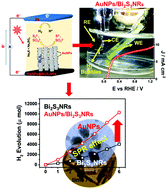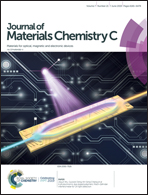Gold nanoparticle decorated bismuth sulfide nanorods for enhanced photoelectrochemical hydrogen production†
Abstract
The design of photo-electrodes with good light absorption, effective photo-generated charge carrier separation and fast charge transportation are key parameters for photoelectrochemical (PEC) hydrogen generation. The development of efficient plasmonic metal–semiconductor hetero-nanostructures has been receiving great attention to obtain the best PEC performance. In this work, we report the synthesis of gold nanoparticles supported on bismuth sulfide nanorods (AuNPs/Bi2S3NRs) as photo-electrodes via hydrothermal and drop-casting methods. The resulting AuNP/Bi2S3NR composites exhibited superior PEC performance for hydrogen production due to their suitable optical/electronic properties. Impressively, the AuNPs/Bi2S3NR photoanode achieved a high photocurrent density of 9.61 mA cm−2 at 1.23 V versus RHE, corresponding to a solar to hydrogen efficiency (STH) of 5.78%, which is about three times higher than that of the pristine Bi2S3 photoanode. Furthermore, the AuNP/Bi2S3NR photoanodes also exhibited a high transient photocurrent response and less charge transfer resistance than the pristine Bi2S3. This enhancement is possibly due to surface plasmon resonance (SPR) of the AuNPs, which improves the light absorption and the charge transfer and minimizes the back transfer and contributes to the overall PEC activity.



 Please wait while we load your content...
Please wait while we load your content...